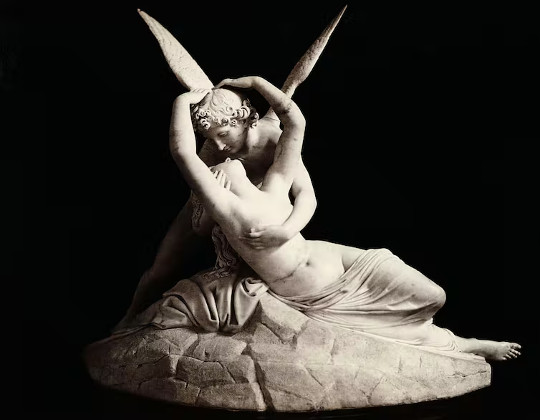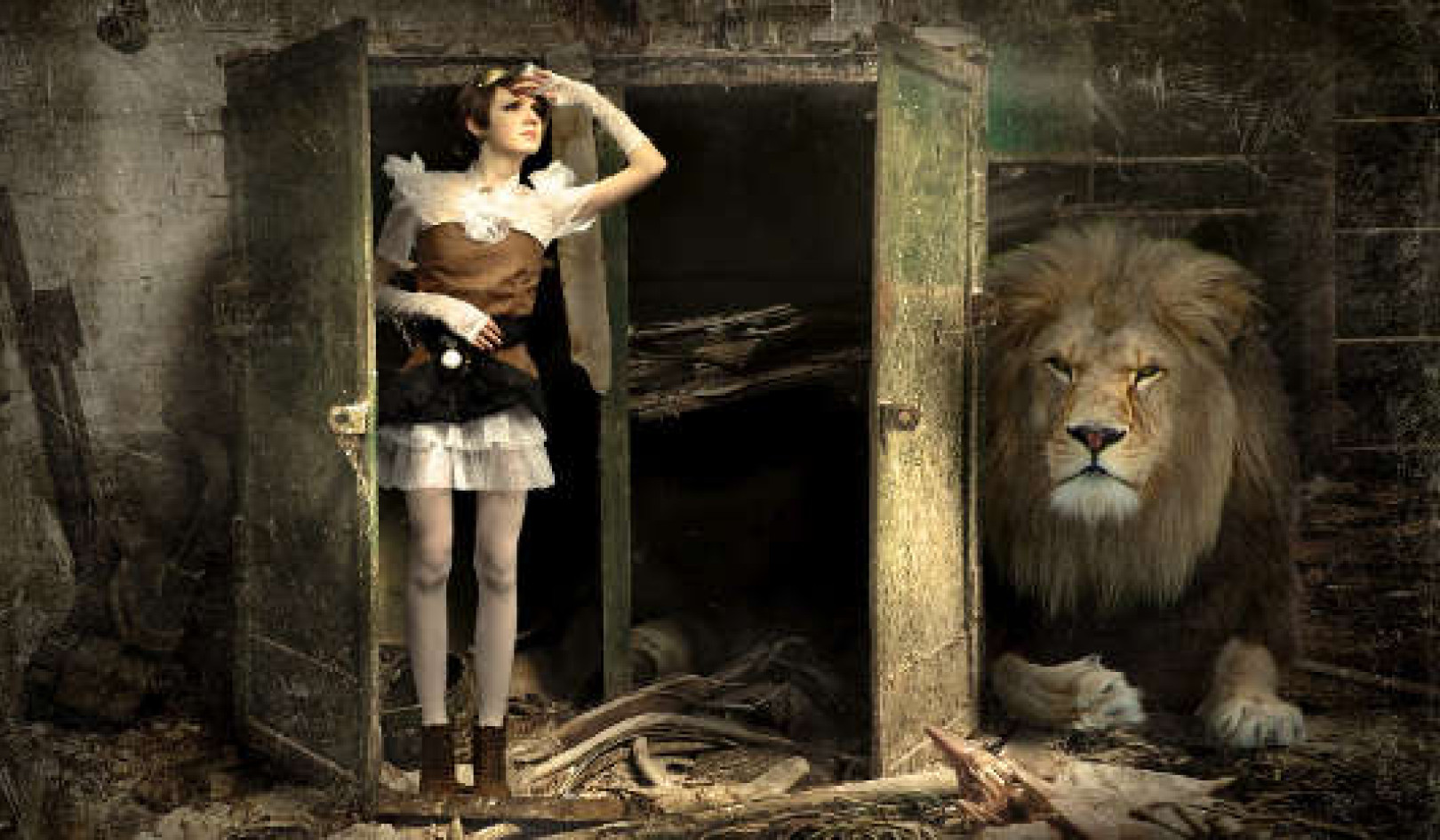
Cupid and Psyche’ by Italian sculptor Antonio Canova. Bettmann via Getty Images
Ah, Valentine’s Day: that Hallmark holiday of greeting cards and chocolates, its bloody origins almost entirely forgotten over the last 2,000 years!
What began as a Christian feast day honoring two or three early Christian martyrs – the original “Valentines” – is now associated with flocks of winged cherubic Cupids, whose innocuous-looking bows and arrows symbolize gentle romance instead of death-dealing war. Somehow, the phrase “struck by Cupid’s arrow” is supposed to be exciting rather than excruciating.
The original Cupid was the son of Venus, Roman goddess of love and beauty. He himself was a Roman deity associated with lust and love, based on the Greek Eros. In Greece and Rome, both figures were depicted as handsome young men, not as winged infants.
But ancient poets and artists also imagined a troop of “Erotes” or “Cupidines” as attendants of these gods. The Romans portrayed them as winged infants, or “putti,” as they became known in Italian Renaissance art. These, in turn, became the chubby cherubs of today’s valentines.
Despite envisioning the god with a troop of adorable attendants, even the Romans understood that Cupid had a darker, more dangerous side – one whose power you wouldn’t want to dismiss.
Small but mighty
The archer god Apollo found this out the hard way, as the poet Ovid told in his epic of A.D. 8, “Metamorphoses.” Having just slain the dragon of Delphi with 1,000 arrows, Apollo provoked the fierce fury of Venus’ son by mocking Cupid’s seemingly toylike weapons.
Cupid swiftly took his revenge. He pierced Apollo’s heart with a golden arrow, causing him to fall passionately in love with the nymph Daphne. But Daphne was a sworn virgin, and Cupid shot her with a lead arrow, intensifying her loathing for all things amorous.
She fled from Apollo’s advances. The desperate deity pursued her relentlessly, until Daphne’s father turned her into a laurel tree to save her. Cupid’s arrows, however diminutive, were more powerful than Apollo’s.
The unseen spouse
But the most famous characterization of Cupid in Latin literature appears in the work of Apuleius, who lived during the second century in what is now Algeria. He wrote a story about Psyche, a princess so exceedingly beautiful that mortals worshipped her as if she were the goddess of love herself.
Enraged by jealousy, Venus commanded her son to make Psyche fall in love with the most wretched man possible. But an oracle told the royal family that their daughter was destined to marry “a savage, untamed creature” that flew about tormenting everyone with fire – and they abandoned her on a cliff to meet this terrifying fate.
Instead, Psyche found herself borne by a gentle breeze to an elaborate palace inhabited by invisible servants. That night, an “unknown husband arrived and made Psyche his wife,” departing before sunrise.
Her unseen spouse continued to visit nightly, and Psyche was soon overjoyed to find herself pregnant. But she also became increasingly lonely. Her mysterious husband agreed that her sisters could visit – as long as she did not try to “investigate his appearance.” She happily agreed, telling him, “Whoever you are I love you deeply. Not even Cupid could compare to you.”
But when Psyche’s two older sisters visited, they became envious of her luxurious life. “She must be married to a god!” they intuited – unlike Psyche, who remained inexplicably clueless. Hoping to break up the marriage, they offered a false explanation for her husband’s secrecy: He must be a monstrous serpent intent on devouring her and her unborn child.
A horrified Psyche believed them, despite her intimate physical knowledge of her spouse – his “perfumed locks, tender cheeks, and warm chest.” Armed with a dagger, she prepared to kill her husband as he slept. But first, ignoring his repeated warnings, she gazed at him by the light of an oil lamp. Here, halfway through the story, the audience finally finds out his identity: none other than Cupid himself!
At the sight, Psyche “fell in love with Love.” But a drop of scalding oil awakened Cupid. Utterly dismayed at his wife’s betrayal, he flew away – but first explained: “I have disobeyed my mother’s orders to fill you with passion for some vile wretch. I flew to you as your lover instead.”
Love lost – and found
The rest of the narrative involves Psyche’s long, arduous quest to win Cupid back. Though despairing and exhausted, Psyche willingly submitted herself to a series of brutal tasks imposed by Venus, only to fall into a deathlike slumber just before completing them.
And where is Cupid during all this? If he is characterized as a powerful, dangerous force in the first half of the story, the second half depicts him as a helpless mama’s boy. He flew back to Venus’ palace, where his mother – furious that he had secretly married Psyche – scolded him righteously, screamed that he had embarrassed her, and locked him in his room.
Finally, recalling his love for Psyche, Cupid escaped out the window and saved her from eternal slumber. Then he made a savvy deal with Jupiter, king of the gods: Psyche could be made immortal, clearing the way for her to “officially” marry Cupid in an arrangement that even satisfied Venus.
Complex vision of love
Apuleius’ story is rare in focusing on a female character and how love and desire affect her. The audience follows Psyche through several rites of passage. Initially, as an unmarried girl, she has not fulfilled her expected role of wife and mother. As a frightened bride, she has no say in whom she marries – an experience common for young wives in ancient Roman society. Love does not enter the picture.
But Apuleius’ portrayal of Psyche’s situation suggests a lesson Roman writers of the day wanted readers to believe: that young married women eventually come to desire and love their husbands. Although that process can be long and difficult, wives and husbands both adjust to their roles over time. The birth of Psyche’s child, “Pleasure,” at the end of the story results in harmony all around, an idealized image of marriage.
Ovid and Apuleius remind us that the original Cupid is not the benign little bearer of valentines but an elemental force of human nature – a “savage, untamed creature” that lights the fires of passion in unpredictable ways. Whereas Apollo’s lust for Daphne’s visible beauty remained unsated, Psyche eventually enjoyed sex with her unseen husband. Apollo learned that longing isn’t always mutual, while Psyche realized that love and trust must be earned.
Apuleius’s story suggests that Cupid and all the intense emotions he represents, once tempered, can provide the basis for a loving, long-lasting relationship. In short, both stories contain valuable lessons about the nature of romance.![]()
About The Author
Debbie Felton, Professor of Classics, UMass Amherst
This article is republished from The Conversation under a Creative Commons license. Read the original article.

Related Books:
The Five Love Languages: The Secret to Love That Lasts
by Gary Chapman
This book explores the concept of "love languages," or the ways in which individuals give and receive love, and offers advice for building strong relationships based on mutual understanding and respect.
Click for more info or to order
The Seven Principles for Making Marriage Work: A Practical Guide from the Country's Foremost Relationship Expert
by John M. Gottman and Nan Silver
The authors, leading relationship experts, offer advice for building a successful marriage based on research and practice, including tips for communication, conflict resolution, and emotional connection.
Click for more info or to order
Come as You Are: The Surprising New Science that Will Transform Your Sex Life
by Emily Nagoski
This book explores the science of sexual desire and offers insights and strategies for enhancing sexual pleasure and connection in relationships.
Click for more info or to order
Attached: The New Science of Adult Attachment and How It Can Help You Find—and Keep—Love
by Amir Levine and Rachel Heller
This book explores the science of adult attachment and offers insights and strategies for building healthy and fulfilling relationships.
Click for more info or to order
The Relationship Cure: A 5 Step Guide to Strengthening Your Marriage, Family, and Friendships
by John M. Gottman
The author, a leading relationship expert, offers a 5-step guide for building stronger and more meaningful relationships with loved ones, based on principles of emotional connection and empathy.























